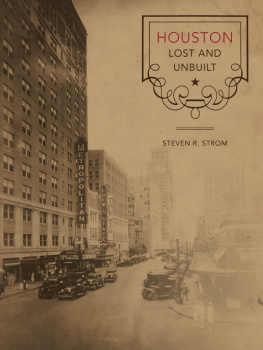Standard History of Houston, Texas
From a study of the original sources
BENAJAH HARVEY CARROLL
Standard History of Houston, B. J. Carroll
Jazzybee Verlag Jrgen Beck
86450 Altenmnster, Loschberg 9
Deutschland
ISBN: 9783849649197
Publicly available via the Woodson Research Center and the Museum of Houston project through the following Creative Commons attribution license: You are free: to copy, distribute, display, and perform the work; to make derivative works; to make commercial use of the work. Under the following conditions: By Attribution.
www.jazzybee-verlag.de
admin@jazzybee-verlag.de
CONTENTS:
PREFACE
The Story of Houston has not proved an easy one to write. A city is in many respects a conglomeration of units rather than an aggregate of unities. the units are of character so varying that it is hard to reduce them to a common denominator. Municipal consciousness is vague and much that happens in the development of a city seems to be fortuitous rather than teleological. Yet Houston has in many respects grown to formula and plan and has often responded heartily to conscious effort made at improvement of conditions. The foundations of the past have been used and effort has been often cumulative in results. Undeniably there is a municipal spirit, an esprit du corps of the citizens that argues well for the future of the town.
The plan followed in writing this history has been to outline the beginnings of things, especially in the days of the Republic, in a manner that in so far as possible follows the order in which the events occurred. After Texas entered the Union the growth of the city is incidentally shown in tracing the growth of the several institutions the aggregate of whose history is the history of the city. The last chapter of the book hinges in a manner directly on to the last chapter on the days of the Republic and outlines the various periods in the municipal life, gives pen pictures of the city at intervals of years, and recapitulates briefly the latest era of greatest achievement.
The volume is true history in that an appeal has been made directly to the sources of history. These have been three; newspapers, there have been newspapers in Houston from the earliest times and it began with a newspaper advertisement; the observations of eye-witnesses as they were recounted in books, especially those of travel and adventure, as to conditions in Houston; and the recollections of the citizens themselves. A number of manuscript letters of Sam Houston and others were also used.
Every extant number of the files of the Telegraph, the Morning Star, the Houston Post and the Houston Chronicle was carefully searched for data, an expert spending four months in going over the newspaper files alone. Matter sufficient for the writing of five volumes the size of this one was obtained and the question of the selection of data assumed importance. Many facts and incidents are given as they are recalled in the memories of old citizens who had personal knowledge of the facts or who participated in the events.
A number of the chapters were written by Dr. S. O. Young, whose family belongs to the earliest settlers and who often writes from personal recollections of events occurring within the last half century. Dr. Young was at one time the editor of the Houston Post, was later the managing editor of the Galveston News and has a wide acquaintance with both local and Texas history and is famed as a raconteur.
A number of chapters, including all those of the period of the Republic and the chapter on the Wm. M. Rice Institute, were written entirely by the editor.
Such statistics as are given without reference to their source are those current in the newspapers of their respective dates or such as are given by those in position to possess true information.
This work may fairly lay claim to the following negative merits:
There is not one line of its text that is advertising. Such mention as is made of firms, persons or corporations is absolutely gratuitous and is made because the editor believed that the person, firm or corporation deserved such mention in fairly telling the story of Houston.
There is no conscious or deliberate padding of facts and figures or exaggeration of statement. The editor feels great pride in Houston, but he has made no attempt to show the city in a rosy glow.
There has been a careful avoidance of the valley of dry bones of municipal politics. Dead issues have been left in their moribund condition fully wrapped in their shrouds and vestments. Only when such important matters as the beginning or ending of the carpet bag government or the change from the old ward system of politics to the commission form of government were to be noted have the issues of municipal campaigns been noticed. Much more has there been an avoidance of state and national politics.
In writing this history special prominence has been given to the Rice Institute because this institution seems certain to play a tremendous part in the city's future history. The sketch of William M. Rice is the only one ever written and in preparing it the men who had known him in his lifetime and his business activities were consulted for information in their possession. It is believed to be a faithful portrayal of the man who takes rank as Houston's greatest benefactor.
Growth in the future will be so rapid that unless some measures are taken to preserve the city's early story it might easily be lost.
Such a volume as the present one, despite the care and trouble necessary to prepare it, necessarily appeals to a circle of readers found within the list of the citizens of Houston itself, together with a few outside students of economic or municipal conditions. It is believed, however, that this book will be of interest and value to all lovers of Houston and the editor chiefly deplores that he has found it impossible to even name all the worthy men and women who have contributed to the growth and prosperity of the city, and will be the first to admit that the services of many here unnamed are worthy to take rank along with the highest and best of those capitulated.
The editor cordially acknowledges the aid and assistance rendered by newspaper writers, by musicians, by architects and by others who have given counsel or advice on matters relating to their professions or callings.
The work is submitted as a record of the achievements of a city that is just three quarters of a century old. The record is carried to a date that varies between February 28, 1911 and November 1, 1911, as the chapters went to press at varying dates. It is the wish of the editor that it may prove to be worthy of the friendly consideration of those who love Houston and believe in her future.
Nov. 21, 1911.
THE EDITOR.
CHAPTER I - Settlement and Pioneer Life
HOUSTON, a Monument to Real Estate Promoters' Art. First Built on Paper and Advertised all over America. Prohibitive Prices of Land at Harrisburg Caused Choice of Houston's Site. Foresight of A. C. and J. K. Allen. The First Steamer up the Bayou. City Mapped and Plotted. Rivalry with Harrisburg. Founding of Harrisburg. Geological Formation of Harris County. Early Social Conditions. Fights and Murders. Civil Officers, Laws and Justice. Building Court House and Jail. First Court Trials, First Wedding, First Divorce. City's Mayors under the Republic. Much Litigation and Many Land Frauds.
Houston is a splendid monument to the success of the real estate promoter's art. Other cities have prospered Topsy wise. They just grew. A lucky place at a cross roads, a river bend or a mountain pass where they might catch the drift from the tides of travel and by the simple process of accretion or the fortuitous concourse of human atoms a city came into being. Not so Houston. Its site was selected by promoters, it was mapped and planned ere ever a house was built, its advantages were touted in the national press and it has performed the singular feat of growing largely according to the plans and specifications originally laid out for its development and has surpassed the most whopping predictions as to its growth and prosperity.










